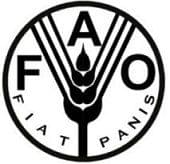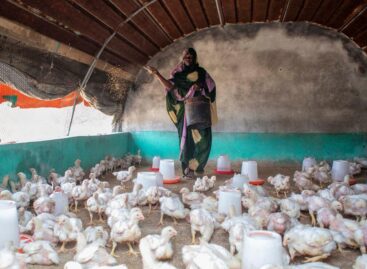The FAO Food Price Index fell for the fifth consecutive year in 2016
The FAO Food Price Index* (FFPI) averaged almost 172 points in December 2016, unchanged from November with strong gains in the prices of vegetable oils and dairy largely offsetting a fall in sugar and meat quotations. For 2016 as a whole, the index averaged 161.6 points, down 1.5 percent from 2015, representing the fifth consecutive annual decline. While prices of sugar and vegetable oils rose significantly in 2016, falling prices in cereal, meat and dairy markets kept the Index below its 2015 average.

» The FAO Cereal Price Index averaged 142.1 points in December, up just 0.5 percent from November and broadly stable since September. International rice prices increased somewhat in December, sustained by official measures put in place in Thailand to prop-up local prices and also strong demand for supplies from Pakistan. While maize quotations also firmed in December, mostly on weather concerns and brisk demand, wheat values weakened as a result of larger than expected production estimates in Australia, Canada and the Russian Federation as well as good crop prospects in Argentina. Overall, the Cereal Price Index averaged around 147 points in 2016, down 9.6 percent from 2015 and as much as 39 percent from its peak in 2011.
» The FAO Vegetable Oil Price Index averaged 183 points in December. Driven primarily by palm and soy oils, the index gained 7.4 points (or 4.2 percent) from November and reached its highest level since July 2014. For palm oil, low global inventory levels and protracted supply tightness continued to bolster prices, while soy oil quotations firmed on both weather concerns in Argentina and the prospect of rising uptake by the biodiesel sector in the United States, Brazil and Argentina. For the year as a whole, the index averaged nearly 164 points, up 11.4 percent from 2015 but well below the values recorded in the preceding five years.
» The FAO Dairy Price Index averaged 192.6 points in December, up 6.2 points (3.3 percent) from November. Moderate rises were recorded for butter, cheese and Whole Milk Powder (WMP), while quotations for Skimmed Milk Powder (SMP) remained stable. Restrained milk production in the EU and Oceania and buoyant international and domestic demand continued to underpin the market. While the Index average for 2016 was 4 percent lower than the previous year, international dairy prices staged a substantial recovery from mid-year onwards, with butter and WMP recording the largest increases.
» The FAO Meat Price Index* averaged 161.5 points in December, 1.8 points (1.1 percent) down from its revised value for November. Quotations for ovine and bovine meat in particular fell, while those for poultry and pig meat were only slightly down. Despite modest growth during the course of the year, the average value of the Index in 2016 was 7 percent below that of 2015, with the largest falls recorded for bovine and poultry meats.
» The FAO Sugar Price Index averaged 262.6 points in December, down 24.6 points (8.6 percent) from November. The sharp fall in international sugar prices in December was mainly driven by a continuous weakening of the Brazilian currency (Real) against the US Dollar, boosting sugar exports from Brazil, the world’s largest sugar producer and exporter. Reports of higher than expected sugar production in 2016/17 (up 18 percent from 2015/16) in the Centre South, Brazil’s main producing region, also contributed to pushing down prices. Overall, however, the FAO Sugar Price Index averaged 255.9 points in 2016, that is 34.2 percent higher than in 2015, the first yearly rise since reaching a peak of 369 points in 2011. The sharp increase in 2016 mostly reflected tighter supplies in Brazil, India and Thailand.
* Unlike for other commodity groups, most prices utilized in the calculation of the FAO Meat Price Index are not available when the FAO Food Price Index is computed and published; therefore, the value of the Meat Price Index for the most recent months is derived from a mixture of projected and observed prices. This can, at times, require significant revisions in the final value of the FAO Meat Price Index which could in turn influence the value of the FAO Food Price Index.
Related news
Road toll hike: agricultural sector backs truckers’ protest, food price increases expected
🎧 Hallgasd a cikket: Lejátszás Szünet Folytatás Leállítás Nyelv: Auto…
Read more >FAO: International food prices have been declining since September
🎧 Hallgasd a cikket: Lejátszás Szünet Folytatás Leállítás Nyelv: Auto…
Read more >FAO-Ministry of Agriculture Scholarship Program Continues
🎧 Hallgasd a cikket: Lejátszás Szünet Folytatás Leállítás Nyelv: Auto…
Read more >Related news
Crowds return to stores: margin cap and year-end preparations drive retail traffic
🎧 Hallgasd a cikket: Lejátszás Szünet Folytatás Leállítás Nyelv: Auto…
Read more >The second big rush in department stores comes between the two holidays
🎧 Hallgasd a cikket: Lejátszás Szünet Folytatás Leállítás Nyelv: Auto…
Read more >Pensioner food vouchers can be redeemed until December 31st
🎧 Hallgasd a cikket: Lejátszás Szünet Folytatás Leállítás Nyelv: Auto…
Read more >






